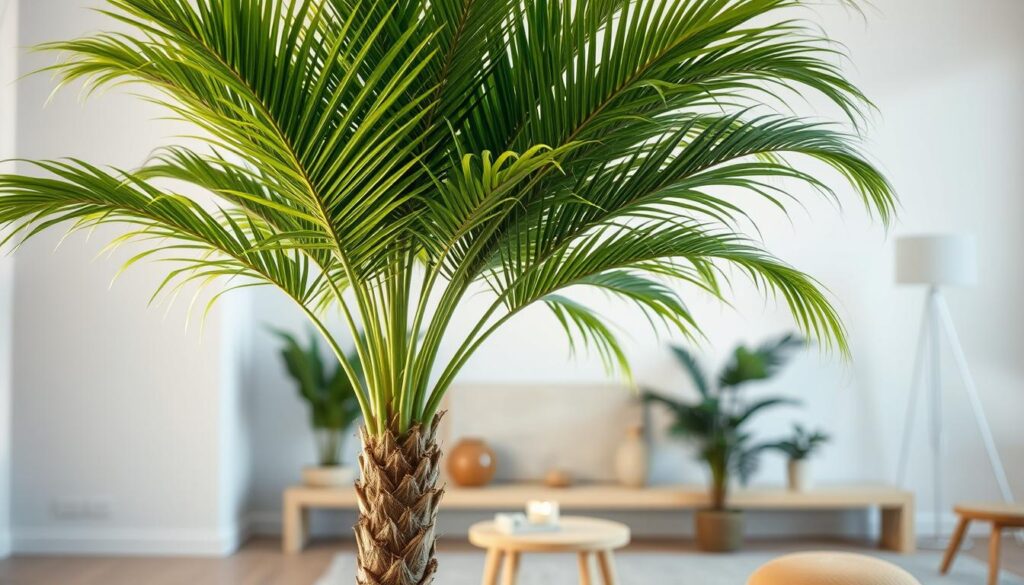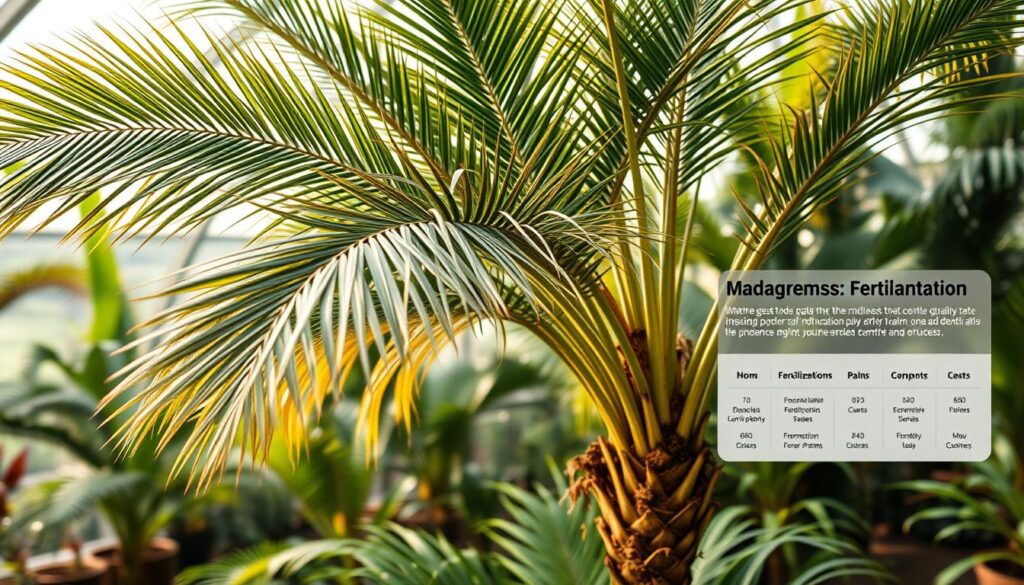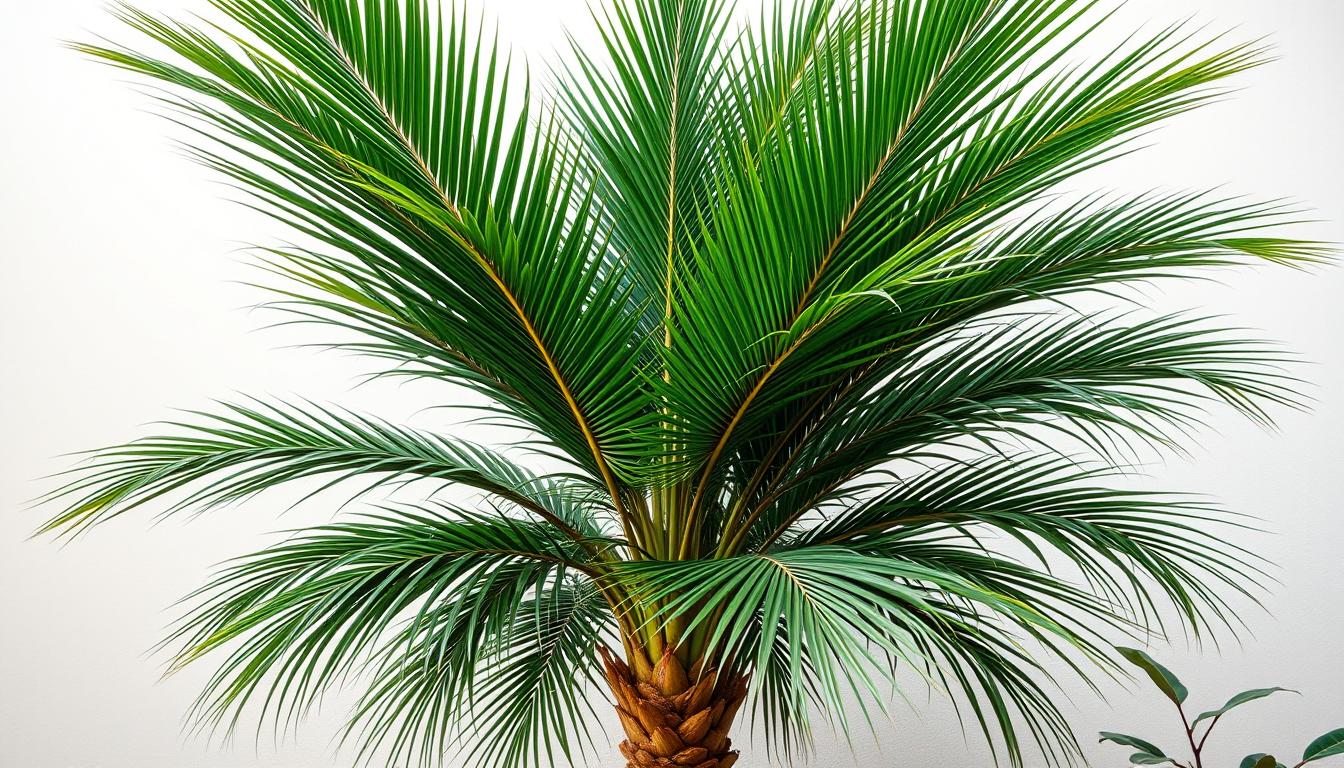Ever seen a Madagascar Palm Plant (Pachypodium lamerei) wither despite your best efforts? It’s really frustrating to see your favorite succulent plants struggle. These exotic houseplants need very specific care that’s different from regular gardening.
The Madagascar Palm Plant isn’t a palm. It’s a remarkable succulent from Madagascar’s unique ecosystem. Its striking look can make any indoor space better, but one small mistake can harm it.
In this guide, we’ll show you the seven most critical care mistakes. These mistakes can harm your Pachypodium lamerei. We’ll help you grow a thriving, stunning plant that’s the highlight of your home.
Table of Contents
Understanding the Madagascar Palm Plant and Its Unique Features
Explore the captivating world of the Madagascar Palm, a standout among exotic houseplants. Known scientifically as Pachypodium Lamerii, it’s not a true palm but a succulent that fascinates plant lovers globally.
These plants come from southern Madagascar’s harsh landscapes. They’ve adapted to survive in tough conditions. Their unique look makes them a favorite among plant enthusiasts.
Natural Habitat and Origins
In its natural home, the Madagascar Palm can grow up to 20 feet tall. It thrives in:
- Arid and semi-arid regions
- Rocky terrain with minimal rainfall
- Areas with intense sunlight and high temperatures
Distinctive Physical Characteristics
The Madagascar Palm stands out because of its special structure:
- Thick, spiny trunk like a cactus
- Long, narrow leaves from the crown
- Potential for stunning white or yellow flowers
Growth Patterns and Expectations
Indoors, your Madagascar Palm will likely grow to about 3 feet tall. It’s slow-growing and needs patience and careful care. Outdoor plants might bloom between 8th and 10th years, but indoor ones rarely do.
“The Madagascar Palm is not just a plant, it’s a living piece of botanical art that brings a touch of exotic wilderness into your home.” – Plant Enthusiast
Knowing these special traits will help you care for your Madagascar Palm. It can become a stunning centerpiece in your home.
The Fatal Error of Improper Watering Techniques
Caring for drought-tolerant plants like the Madagascar Palm is a delicate task. It has special water storage that makes it sensitive to changes in moisture.
Knowing how much water your Madagascar Palm needs is key. Too much water can cause root decay and even kill the plant. These plants prefer to get water only when the soil is dry.
- Check soil moisture before watering
- Use well-draining soil mix
- Allow soil to dry completely between waterings
- Reduce watering during winter months
How often you water depends on the environment. In sunny and warm places, water every 2-3 weeks. In cooler spots, wait 4-5 weeks.
“The key to successful plant care is understanding its natural habitat and mimicking those conditions.” – Plant Care Expert
| Watering Indicators | Action Required |
|---|---|
| Dry, cracked topsoil | Time to water |
| Yellowing leaves | Potential overwatering |
| Wilting despite moist soil | Check root health |
Pro tip: Always use filtered water to avoid potential damage from chlorine and fluorides that can harm your drought-tolerant plants.
Light Requirements: Finding the Perfect Balance
When caring for indoor plants like the Madagascar Palm, knowing about light is key. These plants need the right light to grow well. The Madagascar Palm is a special succulent with its own light needs.
The Madagascar Palm is very sensitive to light. It needs a mix of bright and indirect sunlight to stay healthy. Wrong light can stress and harm the plant.
Direct vs Indirect Sunlight
Your Madagascar Palm likes bright, indirect light. Direct sun can burn leaves and hurt the plant. Here’s what to do:
- Put it near the east or west windows
- Use curtains to soften strong sun
- Turn the plant often for balanced light
Seasonal Light Adjustments
Light needs to change with the seasons. In winter, your plant might need more artificial light or a new spot.
Signs of Light-Related Stress
Look out for these signs of bad light:
- Yellowing leaves: Too much direct sun
- Leggy growth: Not enough light
- Brown leaf tips: Too much stress from light
“Understanding your plant’s light needs is the key to successful indoor gardening.” – Plant Care Experts
Temperature and Humidity Blunders to Avoid

Caring for tropical plants like the Madagascar Palm is all about temperature and humidity. Your indoor plants need specific conditions to grow well. Knowing these details can greatly improve your plant’s health.
Temperature is key for your Madagascar Palm. It does best in a temperature range of 65° to 75° Fahrenheit. Big temperature changes can harm your plant, causing leaf damage or drop.
- Daytime ideal temperature: 70°F to 90°F
- Nighttime preferred temperature: 60°F to 65°F
- Critical temperature threshold: Below 50°F is dangerous
Look out for these signs of temperature stress:
- Yellow leaves: This might mean your plant is too hot.
- Brown leaf edges: This could be a sign of cold stress.
- Leaf drop: Big temperature changes are a warning.
Humidity is also very important for your Madagascar Palm’s health. These tropical plants like moderate humidity. Most homes have the right humidity for them. Try to keep humidity at 40-50% to avoid leaf problems.
Here are some tips for managing humidity:
- Use a hygrometer to check humidity levels.
- Group plants together to create a microclimate.
- Avoid too much misting, which can make plants too wet.
By keeping the right temperature and humidity, you’ll give your Madagascar Palm the best chance to thrive indoors.
Madagascar Palm Plant Soil and Potting Requirements
To make your Madagascar palm happy, you need to know about its soil and potting needs. This drought-tolerant plant is special and needs the right growing conditions.
Your Madagascar palm loves a soil mix that’s similar to its home. You should make a special soil blend to help it grow well.
Ideal Soil Composition
Creating the right soil mix is key for these plants. Here’s what you should mix:
- 2 parts potting soil
- 2 parts sharp sand
- 1 part peat or coir
Drainage Essentials
Good drainage is vital for this plant. Bad drainage can cause root rot. Use a pot with holes and a soil mix that drains water fast.
Repotting Guidelines
Repotting is important for your Madagascar palm. Watch for these signs to know when to report:
- Roots peeking out of drainage holes
- Roots circling the surface of the soil
- Plants becoming top-heavy or thick
Pro tip: The best time to repot is in spring or early summer. This helps the plant recover and grow new roots.
Your Madagascar palm needs a new pot every three years. Wear gloves when repotting because the plant is toxic. Maintain the soil pH between 6.1 and 7.8. Make sure the pot is big enough, about 36 to 48 inches wide.
Feeding and Fertilization Mistakes

When you care for exotic houseplants like the Madagascar palm, knowing how to fertilize is key. Many people make mistakes that can hurt this plant’s growth and health.
Understanding the plant’s nutritional needs is the first step. Madagascar palms need a balanced diet to grow well.
- Apply a diluted houseplant fertilizer at the start of spring and summer.
- Avoid over-fertilizing, which can damage the plant’s delicate root system
- Choose a low-nitrogen fertilizer to prevent excessive leaf growth
During the growing season, fertilize your Madagascar palm about once a month. Pro tip: Cut back on fertilizing in winter when the plant rests. This helps the plant grow naturally.
Picking the right fertilizer is important for these plants. A cactus or succulent fertilizer with a balanced NPK ratio works best. Always dilute it to half the recommended amount to avoid harming the roots.
Remember: Less is more when fertilizing your Madagascar palm!
Look out for signs of too much fertilizer, like yellow leaves or slow growth. These plants do best with a little food, just like their natural habitats.
Common Pest Problems and Prevention
Keeping your Madagascar Palm safe from pests is key to its health. These exotic plants can attract tiny invaders that harm their health and look. It’s important to protect them.
Pests can quickly ruin your beautiful plant. Knowing the common pests helps you keep your Madagascar Palm healthy.
Identifying Common Pests
Your Madagascar Palm might attract several pests:
- Mealybugs: Small, white cottony insects that cluster in leaf joints
- Spider mites: Tiny red or brown insects creating fine webs on leaves
- Aphids: Tiny green or black insects that feed on plant sap.
- Scale Insects: Hard-shelled pests that cling to stems and leaves.
Natural Treatment Methods
For pest control, natural methods work well:
- Neem oil spray for comprehensive pest control
- Insecticidal soap for gentle yet effective treatment
- Rubbing alcohol solution to remove stubborn insects
- Introduce beneficial predatory insects like ladybugs
Preventive Measures
To protect your plants, take these steps:
- Inspect plants weekly for early pest detection
- Maintain proper humidity levels around 40%
- Ensure good air circulation
- Keep plants clean by gently wiping leaves
- Isolate new plants before adding them to your collection.
Remember, prevention is always easier than treating a full-blown pest infestation in your Madagascar Palm.
Pruning and Maintenance Errors
Keeping your Pachypodium lamerei healthy means paying close attention to pruning. This low maintenance plant still needs careful care to stay vibrant. Mistakes in pruning can harm its growth and health.
Many gardeners face challenges when pruning this unique succulent. It’s important to understand its needs and how to handle it gently.
- Prune only during late winter to early spring
- Use sterilized cutting tools to prevent infections
- Remove dead or yellowing leaves carefully
- Avoid cutting more than 20% of the plant at once
Your Madagascar Palm doesn’t grow back like regular shrubs. Each cut is permanent, so you must be precise. Watch the plant closely after pruning for signs of stress like leaf color changes or drooping.
Proper care after pruning is key. Water the plant gently to help it heal. Clean, precise cuts can encourage new growth, making the plant look 20-40% better. Recovery times vary, with some palms showing new growth quickly and others taking months.
Using clean tools and being careful with pruning is crucial. Sterilizing your tools can cut infection risks by 50%. This protects your Pachypodium lamerei from harm.
Pruning is an art of patience and precision with the Madagascar Palm.
Propagation Challenges and Solutions
Propagating the Madagascar Palm can be tricky for plant lovers. But, with the right techniques, you can grow more of these unique plants. This includes both bonsai and succulent plants.
The best way to grow Madagascar Palm is through seed germination. You need to create the perfect conditions for growth. Seeds need special care to grow into strong plants.
Best Practices for Seed Propagation
- Maintain warm temperatures between 65–85°F (18–29°C)
- Keep seeds consistently moist during germination
- Use well-draining soil mix
- Provide indirect light during initial growth stages
Step-by-Step Propagation Guide
- Collect mature seeds from a healthy Madagascar Palm
- Prepare a warm, humid environment
- Plant seeds in a light, sandy soil mixture
- Maintain consistent moisture without overwatering
- Wait patiently for germination (can take several weeks)
For bonsai fans, the Madagascar Palm is a great choice. Its unique trunk and slow growth make it perfect for mini plants. Remember, patience is crucial when growing these plants.
Pro tip: Once established, the Madagascar Palm needs little care. With the right care, your plants can live for decades. They’ll be a beautiful part of your plant collection.
Conclusion
Starting your journey with the Madagascar Palm Plant is exciting. It needs careful attention and understanding. By following the tips in this guide, you can make your plant grow strong and learn a lot about gardening.
Keeping safe is key when you have a Madagascar Palm Plant. This beautiful plant can be risky because of its calcium oxalate crystals. Always wear gloves when handling it. Keep it out of reach of kids and pets to avoid accidents.
Knowing how to care for your exotic houseplant is important. It needs the right amount of water, light, temperature, and soil. Paying attention to these details helps your plant thrive. With time and effort, your Madagascar Palm Plant will become a beautiful centerpiece in your home.
By learning and using these care tips, you’ll have a healthy Madagascar Palm Plant. It will not only survive but also grow well in your home. Enjoy the process of becoming a skilled plant caretaker.
FAQ
What makes the Madagascar Palm Plant (Pachypodium lamerei) unique?
The Madagascar Palm Plant is a special succulent from Madagascar. It has a thick, spiny trunk and long, narrow leaves. Unlike real palm trees, it store water well and can survive without much water. This makes it a unique and easy-to-care-for houseplant.
How frequently should I water my Madagascar Palm Plant?
This succulent needs very little water. In spring and summer, water it when the top 2-3 inches of soil are dry. In winter, water it even less, letting the soil dry out completely to avoid root rot.
What type of light does a Madagascar Palm Plant need?
It loves bright, indirect sunlight. Position it near a window with indirect light. Avoid direct sunlight in the afternoon to prevent leaf damage. For indoor growing, a south or west-facing window with a curtain is best.
What are the ideal temperature conditions for this plant?
It prefers warm temperatures between 65-85°F (18-29°C). It can’t handle cold drafts or temperatures below 50°F (10°C). Keep it warm in winter, away from cold windows.
What type of soil is best for a Madagascar Palm Plant?
Use a mix made for cacti or succulents. Add perlite or sand for better drainage. The soil should be slightly acidic and drain water quickly to prevent root rot. Ensure the pot has drainage holes.
How do I fertilize my Madagascar Palm Plant?
Use a balanced fertilizer diluted to half-strength in spring and summer. Feed it monthly during this time. Stop fertilizing in fall and winter when it’s dormant. Too much fertilizer can harm the roots.
What common pests affect Madagascar Palm Plants?
Spider mites and mealybugs are common pests. Check your plant often. If you see webs or white clusters, treat it with neem oil or insecticidal soap. Good air circulation and avoiding overwatering help prevent pests.
Can I propagate a Madagascar Palm Plant?
Propagation is hard and slow. Growing from seeds is the best method, but it takes patience and specific conditions. Germination can take weeks, and growth is slow. For better results, consider professional propagation.
Is the Madagascar Palm Plant toxic?
Yes, it’s toxic to pets and humans if eaten. Its sap can irritate skin, and eating any part can cause serious health problems. Keep it away from children and pets, and wear gloves when handling or pruning.

